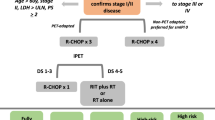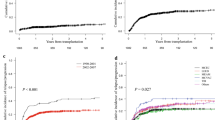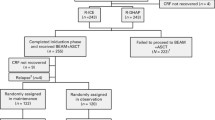Abstract
Despite more effective front-line regimens, a substantial portion of patients with diffuse large B-cell lymphoma relapse and require further therapy. Several trials have established the efficacy of autologous stem cell transplantation for relapsed diffuse large B-cell lymphomas, but the benefit has been largely restricted to patients with chemosensitive disease and low-risk features at the time of relapse. In an effort to improve outcomes following an autologous transplant, researchers are exploring several avenues, including improvement of salvage regimens, addition of radioimmunotherapy to preparative regimens, and application of posttransplant treatments to eliminate minimal residual disease. Allogeneic stem cell transplantation also appears promising, but there is much to learn about optimal patient selection and timing. This review outlines the current approach to the management of relapsed diffuse large B-cell lymphoma, with an emphasis on newer peritransplant therapies.
Similar content being viewed by others
References and Recommended Reading
Coiffier B, Lepage E, Briere J, et al.: CHOP chemotherapy plus rituximab compared with CHOP alone in elderly patients with diffuse large-B-cell lymphoma. N Engl J Med 2002, 346:235–242.
Feugier P, Van Hoof A, Sebban C, et al.: Long-term results of the R-CHOP study in the treatment of elderly patients with diffuse large B-cell lymphoma: a study by the Groupe d’Etude des Lymphomes de l’Adulte. J Clin Oncol 2005, 23:4117–4126.
Habermann TM, Weller EA, Morrison VA, et al.: Rituximab-CHOP versus CHOP alone or with maintenance rituximab in older patients with diffuse large B-cell lymphoma. J Clin Oncol 2006, 24:3121–3127.
Pfreundschuh M, Kloess M, Zeynalava E, et al.: Six vs. eight cycles of bi-weekly CHOP-14 with or without rituximab for elderly patients with diffuse large B-cell lymphoma (DLBCL): results of the completed RICOVER-60 trial of the German High-Grade Non-Hodgkin Lymphoma Study Group (DSHNHL) [abstract]. Blood 2006, 108:abstract 205.
Pfreundschuh M, Trumper L, Osterborg A, et al.: CHOP-like chemotherapy plus rituximab versus CHOP-like chemotherapy alone in young patients with good-prognosis diffuse large-B-cell lymphoma: a randomised controlled trial by the MabThera International Trial (MInT) Group. Lancet Oncol 2006, 7:379–391.
Coiffier B, Feugier P, Mounier N, et al.: Long-term results of the GELA study comparing R-CHOP and CHOP chemotherapy in older patients with diffuse large B-cell lymphoma show good survival in poor-risk patients [ASCO abstract]. J Clin Oncol 2007, 25(18S):8009.
A predictive model for aggressive non-Hodgkin’s lymphoma. The International Non-Hodgkin’s Lymphoma Prognostic Factors Project. N Engl J Med 1993, 329:987–994.
Sehn LH, Berry B, Chhanabhai M, et al.: The revised International Prognostic Index (R-IPI) is a better predictor of outcome than the standard IPI for patients with diffuse large B-cell lymphoma treated with R-CHOP. Blood 2007, 109:1857–1861.
Philip T, Guglielmi C, Hagenbeek A, et al.: Autologous bone marrow transplantation as compared with salvage chemotherapy in relapses of chemotherapy-sensitive non-Hodgkin’s lymphoma. N Engl J Med 1995, 333:1540–1545.
Cheson BD, Pfistner B, Juweid ME, et al.: Revised response criteria for malignant lymphoma. J Clin Oncol 2007, 25:579–586.
Shipp MA, Abeloff MD, Antman KH, et al.: International consensus conference on high-dose therapy with hematopoietic stem cell transplantation in aggressive non-Hodgkin’s lymphomas: report of the jury. J Clin Oncol 1999, 17:423–429.
Vose JM, Rizzo DJ, Tao-Wu J, et al.: Autologous transplantation for diffuse aggressive non-Hodgkin lymphoma in first relapse or second remission. Biol Blood Marrow Transplant 2004, 10:116–127.
Josting A, Sieniawski M, Glossmann JP, et al.: High-dose sequential chemotherapy followed by autologous stem cell transplantation in relapsed and refractory aggressive non-Hodgkin’s lymphoma: results of a multicenter phase II study. Ann Oncol 2005, 16:1359–1365.
Blay J, Gomez F, Sebban C, et al.: The International Prognostic Index correlates to survival in patients with aggressive lymphoma in relapse: analysis of the Parma trial. Parma Group. Blood 1998, 92:3562–3568.
Hamlin PA, Zelenetz AD, Kewalramani T, et al.: Age-adjusted International Prognostic Index predicts autologous stem cell transplantation outcome for patients with relapsed or primary refractory diffuse large B-cell lymphoma. Blood 2003, 102:1989–1996.
Costa LJ, Micallef IN, Inwards DJ, et al.: Time of relapse after initial therapy significantly adds to the prognostic value of the IPI-R in patients with relapsed DLBCL under-going autologous stem cell transplantation. Bone Marrow Transplant 2008, 41:715–720.
Moskowitz CH, Bertino JR, Glassman JR, et al.: Ifosfamide, carboplatin, and etoposide: a highly effective cytoreduction and peripheral-blood progenitor-cell mobilization regimen for transplant-eligible patients with non-Hodgkin’s lymphoma. J Clin Oncol 1999, 17:3776–3785.
Schot BW, Zijlstra JM, Sluiter WJ, et al.: Early FDGPET assessment in combination with clinical risk scores determines prognosis in recurring lymphoma. Blood 2007, 109:486–491.
Spaepen K, Stroobants S, Dupont P, et al.: Early restaging positron emission tomography with (18)F-fluorodeoxyglucose predicts outcome in patients with aggressive non-Hodgkin’s lymphoma. Ann Oncol 2002, 13:1356–1363.
Svoboda J, Andreadis C, Elstrom R, et al.: Prognostic value of FDG-PET scan imaging in lymphoma patients undergoing autologous stem cell transplantation. Bone Marrow Transplant 2006, 38:211–216.
Crocchiolo R, Canevari C, Assanelli A, et al.: Pre-transplant 18FDG-PET predicts outcome in lymphoma patients treated with high-dose sequential chemotherapy followed by autologous stem cell transplantation. Leuk Lymphoma 2008, 49:727–733.
Alizadeh AA, Eisen MB, Davis RE, et al.: Distinct types of diffuse large B-cell lymphoma identified by gene expression profiling. Nature 2000, 403:503–511.
Moskowitz CH, Zelenetz AD, Kewalramani T, et al.: Cell of origin, germinal center versus nongerminal center, determined by immunohistochemistry on tissue microarray, does not correlate with outcome in patients with relapsed and refractory DLBCL. Blood 2005, 106:3383–3385.
Kewalramani T, Zelenetz AD, Hedrick EE, et al.: High-dose chemoradiotherapy and autologous stem cell transplantation for patients with primary refractory aggressive non-Hodgkin lymphoma: an intention-to-treat analysis. Blood 2000, 96:2399–2404.
Vose JM, Zhang MJ, Rowlings PA, et al.: Autologous transplantation for diffuse aggressive non-Hodgkin’s lymphoma in patients never achieving remission: a report from the Autologous Blood and Marrow Transplant Registry. J Clin Oncol 2001, 19:406–413.
Rodriguez J, Caballero MD, Gutierrez A, et al.: Autologous stem-cell transplantation in diffuse large B-cell non-Hodgkin’s lymphoma not achieving complete response after induction chemotherapy: the GEL/TAMO experience. Ann Oncol 2004, 15:1504–1509.
Corazzelli G, Russo F, Capobianco G, et al.: Gemcitabine, ifosfamide, oxaliplatin and rituximab (R-GIFOX), a new effective cytoreductive/mobilizing salvage regimen for relapsed and refractory aggressive non-Hodgkin’s lymphoma: results of a pilot study. Ann Oncol 2006, 17(Suppl 4):iv18–iv24.
van Besien K, Rodriguez A, Tomany S, et al.: Phase II study of a high-dose ifosfamide-based chemotherapy regimen with growth factor rescue in recurrent aggressive NHL. High response rates and limited toxicity, but limited impact on long-term survival. Bone Marrow Transplant 2001, 27:397–404.
Vellenga E, van Putten WL, van’ t Veer MB, et al.: Rituximab improves the treatment results of DHAP-VIM-DHAP and ASCT in relapsed/progressive aggressive CD20+ NHL: a prospective randomized HOVON trial. Blood 2008, 111:537–543.
Kewalramani T, Zelenetz AD, Nimer SD, et al.: Rituximab and ICE as second-line therapy before autologous stem cell transplantation for relapsed or primary refractory diffuse large B-cell lymphoma. Blood 2004, 103:3684–3688.
Sieniawski M, Staak O, Glossmann JP, et al.: Rituximab added to an intensified salvage chemotherapy program followed by autologous stem cell transplantation improved the outcome in relapsed and refractory aggressive non-Hodgkin lymphoma. Ann Hematol 2007, 86:107–115.
Fenske TS, Parameswaran H, Carreras J, et al.: Pretransplant rituximab therapy is associated with improved progression-free and overall survival in patients undergoing autologous hematopoietic stem cell transplantation for diffuse large B-cell lymphoma (DLBCL) [abstract]. Blood 2007, 110:abstract 19.
Gisselbrecht C, Schmitz N, Mounier N, et al.: R-ICE versus R-DHAP in relapsed patients with CD20 diffuse large B-cell lymphoma (DLBCL) followed by stem cell transplantation and maintenance treatment with rituximab or not: first interim analysis on 200 patients. CORAL study [abstract 517]. Blood 2007, 110:159a.
Friedberg JW, Neuberg D, Stone RM, et al.: Outcome in patients with myelodysplastic syndrome after autologous bone marrow transplantation for non-Hodgkin’s lymphoma. J Clin Oncol 1999; 17:3128–3135.
Milligan DW, Ruiz De Elvira MC, Kolb HJ, et al.: Secondary leukaemia and myelodysplasia after autografting for lymphoma: results from the EBMT. EBMT Lymphoma and Late Effects Working Parties. European Group for Blood and Marrow Transplantation. Br J Haematol 1999, 106:1020–1026.
Press OW, Eary JF, Appelbaum FR, et al.: Radiolabeled-antibody therapy of B-cell lymphoma with autologous bone marrow support. N Engl J Med 1993, 329:1219–1224.
Gopal AK, Rajendran JG, Gooley TA, et al.: High-dose [131I]tositumomab (anti-CD20) radioimmunotherapy and autologous hematopoietic stem-cell transplantation for adults > or = 60 years old with relapsed or refractory B-cell lymphoma. J Clin Oncol 2007, 25:1396–1402.
Liu SY, Eary JF, Petersdorf SH, et al.: Follow-up of relapsed B-cell lymphoma patients treated with iodine-131-labeled anti-CD20 antibody and autologous stem-cell rescue. J Clin Oncol 1998, 16:3270–3278.
Vose JM, Bierman PJ, Enke C, et al.: Phase I trial of iodine-131 tositumomab with high-dose chemotherapy and autologous stem-cell transplantation for relapsed non-Hodgkin’s lymphoma. J Clin Oncol 2005, 23:461–467.
Vose J, Bierman PJ, Bociek G, et al.: Radioimmunotherapy with 131-I tositumomab enhanced survival in good prognosis relapsed and high-risk diffuse large B-cell lymphoma (DLBCL) patients receiving high-dose chemotherapy and autologous stem cell transplantation [ASCO abstract 8013]. J Clin Oncol 2007, 25(18S):8013.
Krishnan A, Nademanee A, Fung HC, et al.: Phase II trial of a transplantation regimen of yttrium-90 ibritumomab tiuxetan and high-dose chemotherapy in patients with non-Hodgkin’s lymphoma. J Clin Oncol 2008, 26:90–95.
Nademanee A, Forman S, Molina A, et al.: A phase 1/2 trial of high-dose yttrium-90-ibritumomab tiuxetan in combination with high-dose etoposide and cyclophosphamide followed by autologous stem cell transplantation in patients with poor-risk or relapsed non-Hodgkin lymphoma. Blood 2005, 106:2896–2902.
Shimoni A, Zwas ST, Oksman Y, et al.: Yttrium-90-ibritumomab tiuxetan (Zevalin) combined with high-dose BEAM chemotherapy and autologous stem cell transplantation for chemo-refractory aggressive non-Hodgkin’s lymphoma. Exp Hematol 2007, 35:534–540.
Winter JN, Inwards DJ, Spies S, et al.: 90Y ibritumomab tiuxetan (Zevalin; 90YZ) doses calculated to deliver up to 1500 cGy to critical organs may be safely combined with high-dose BEAM and autotransplant in NHL [abstract 330]. Blood 2006, 108:127.
Alousi AM, Hosing C, Saliba R, et al.: Zevalin/BEAM/rituximab vs BEAM/rituximab and autologous stem cell transplantation (ASCT) for relapsed chemosensitive diffuse large B-cell lymphoma (DLBCL): impact of the IPI and PET status [abstract]. Blood 2007, 110:620.
Vose JM, Bierman PJ, Anderson JR, et al.: Progressive disease after high-dose therapy and autologous transplantation for lymphoid malignancy: clinical course and patient follow-up. Blood 1992, 80:2142–2148.
Kewalramani T, Nimer SD, Zelenetz AD, et al.: Progressive disease following autologous transplantation in patients with chemosensitive relapsed or primary refractory Hodgkin’s disease or aggressive non-Hodgkin’s lymphoma. Bone Marrow Transplant 2003, 32:673–679.
Pott C, Schrader C, Gesk S, et al.: Quantitative assessment of molecular remission after high-dose therapy with autologous stem cell transplantation predicts long-term remission in mantle cell lymphoma. Blood 2006, 107:2271–2278.
Khouri IF, Saliba RM, Hosing C, et al.: Concurrent administration of high-dose rituximab before and after autologous stem-cell transplantation for relapsed aggressive B-cell non-Hodgkin’s lymphomas. J Clin Oncol 2005, 23:2240–2247.
Horwitz SM, Negrin RS, Blume KG, et al.: Rituximab as adjuvant to high-dose therapy and autologous hematopoietic cell transplantation for aggressive non-Hodgkin lymphoma. Blood 2004, 103:777–783.
Shimoni A, Hardan I, Avigdor A, et al.: Rituximab reduces relapse risk after allogeneic and autologous stem cell transplantation in patients with high-risk aggressive non-Hodgkin’s lymphoma. Br J Haematol 2003, 122:457–464.
Lee MY, Chiou TJ, Hsiao LT, et al.: Rituximab therapy increased post-transplant cytomegalovirus complications in Non-Hodgkin’s lymphoma patients receiving autologous hematopoietic stem cell transplantation. Ann Hematol 2008, 87:285–289.
Lemieux B, Tartas S, Traulle C, et al.: Rituximab-related late-onset neutropenia after autologous stem cell transplantation for aggressive non-Hodgkin’s lymphoma. Bone Marrow Transplant 2004, 33:921–923.
Shortt J, Spencer A: Adjuvant rituximab causes prolonged hypogammaglobulinaemia following autologous stem cell transplant for non-Hodgkin’s lymphoma. Bone Marrow Transplant 2006, 38:433–436.
Borrello I, Sotomayor EM, Rattis FM, et al.: Sustaining the graft-versus-tumor effect through posttransplant immunization with granulocyte-macrophage colony-stimulating factor (GM-CSF)-producing tumor vaccines. Blood 2000, 95:3011–3019.
Kline J, Subbiah S, Lazarus HM, van Besien K: Autologous graft-versus-host disease: harnessing anti-tumor immunity through impaired self-tolerance. Bone Marrow Transplant 2008, 41:505–513.
Thompson JA, Fisher RI, Leblanc M, et al.: Total body irradiation, etoposide, cyclophosphamide, and autologous peripheral blood stem-cell transplantation followed by randomization to therapy with interleukin-2 versus observation for patients with non-Hodgkin lymphoma: results of a phase 3 randomized trial by the Southwest Oncology Group (SWOG 9438). Blood 2008, 111:4048–4054.
Peniket AJ, Ruiz de Elvira MC, Taghipour G, et al.: An EBMT registry matched study of allogeneic stem cell transplants for lymphoma: allogeneic transplantation is associated with a lower relapse rate but a higher procedure-related mortality rate than autologous transplantation. Bone Marrow Transplant 2003, 31:667–678.
van Besien KW, de Lima M, Giralt SA, et al.: Management of lymphoma recurrence after allogeneic transplantation: the relevance of graft-versus-lymphoma effect. Bone Marrow Transplant 1997, 19:977–982.
Dhedin N, Giraudier S, Gaulard P, et al.: Allogeneic bone marrow transplantation in aggressive non-Hodgkin’s lymphoma (excluding Burkitt and lymphoblastic lymphoma): a series of 73 patients from the SFGM database. Societe Francaise de Greffe de Moelle. Br J Haematol 1999, 107:154–161.
Doocey RT, Toze CL, Connors JM, et al.: Allogeneic haematopoietic stem-cell transplantation for relapsed and refractory aggressive histology non-Hodgkin lymphoma. Br J Haematol 2005, 131:223–230.
Rodriguez R, Nademanee A, Ruel N, et al.: Comparison of reduced-intensity and conventional myeloablative regimens for allogeneic transplantation in non-Hodgkin’s lymphoma. Biol Blood Marrow Transplant 2006, 12:1326–1334.
Faulkner RD, Craddock C, Byrne JL, et al.: BEAM-alemtuzumab reduced-intensity allogeneic stem cell transplantation for lymphoproliferative diseases: GVHD, toxicity, and survival in 65 patients. Blood 2004, 103:428–434.
Morris E, Thomson K, Craddock C, et al.: Outcomes after alemtuzumab-containing reduced-intensity allogeneic transplantation regimen for relapsed and refractory non-Hodgkin lymphoma. Blood 2004, 104:3865–3871.
Robinson SP, Goldstone AH, Mackinnon S, et al.: Chemoresistant or aggressive lymphoma predicts for a poor outcome following reduced-intensity allogeneic progenitor cell transplantation: an analysis from the Lymphoma Working Party of the European Group for Blood and Bone Marrow Transplantation. Blood 2002, 100:4310–4316.
Freytes CO, Loberiza FR, Rizzo JD, et al.: Myeloablative allogeneic hematopoietic stem cell transplantation in patients who experience relapse after autologous stem cell transplantation for lymphoma: a report of the International Bone Marrow Transplant Registry. Blood 2004, 104:3797–3803.
Escalon MP, Champlin RE, Saliba RM, et al.: Nonmyeloablative allogeneic hematopoietic transplantation: a promising salvage therapy for patients with non-Hodgkin’s lymphoma whose disease has failed a prior autologous transplantation. J Clin Oncol 2004, 22:2419–2423.
Branson K, Chopra R, Kottaridis PD, et al.: Role of nonmyeloablative allogeneic stem-cell transplantation after failure of autologous transplantation in patients with lymphoproliferative malignancies. J Clin Oncol 2002, 20:4022–4031.
Baron F, Storb R, Storer BE, et al.: Factors associated with outcomes in allogeneic hematopoietic cell transplantation with nonmyeloablative conditioning after failed myeloablative hematopoietic cell transplantation. J Clin Oncol 2006, 24:4150–4157.
El Gnaoui T, Dupuis J, Belhadj K, et al.: Rituximab, gemcitabine and oxaliplatin: an effective salvage regimen for patients with relapsed or refractory B-cell lymphoma not candidates for high-dose therapy. Ann Oncol 2007, 18:1363–1368.
Lopez A, Gutierrez A, Palacios A, et al.: GEMOX-R regimen is a highly effective salvage regimen in patients with refractory/relapsing diffuse large-cell lymphoma: a phase II study. Eur J Haematol 2008, 80:127–132.
Morschhauser F, Illidge T, Huglo D, et al.: Efficacy and safety of yttrium-90 ibritumomab tiuxetan in patients with relapsed or refractory diffuse large B-cell lymphoma not appropriate for autologous stem-cell transplantation. Blood 2007, 110:54–58.
Press OW, Eary JF, Gooley T, et al.: A phase I/II trial of iodine-131-tositumomab (anti-CD20), etoposide, cyclophosphamide, and autologous stem cell transplantation for relapsed B-cell lymphomas. Blood 2000, 96:2934–2942.
Gopal AK, Pagel JM, Rajendran JG, et al.: Improving the efficacy of reduced intensity allogeneic transplantation for lymphoma using radioimmunotherapy. Biol Blood Marrow Transplant 2006, 12:697–702.
Author information
Authors and Affiliations
Corresponding author
Rights and permissions
About this article
Cite this article
Kenkre, V.P., Smith, S.M. Management of relapsed diffuse large B-cell lymphoma. Curr Oncol Rep 10, 393–403 (2008). https://doi.org/10.1007/s11912-008-0061-4
Published:
Issue Date:
DOI: https://doi.org/10.1007/s11912-008-0061-4




